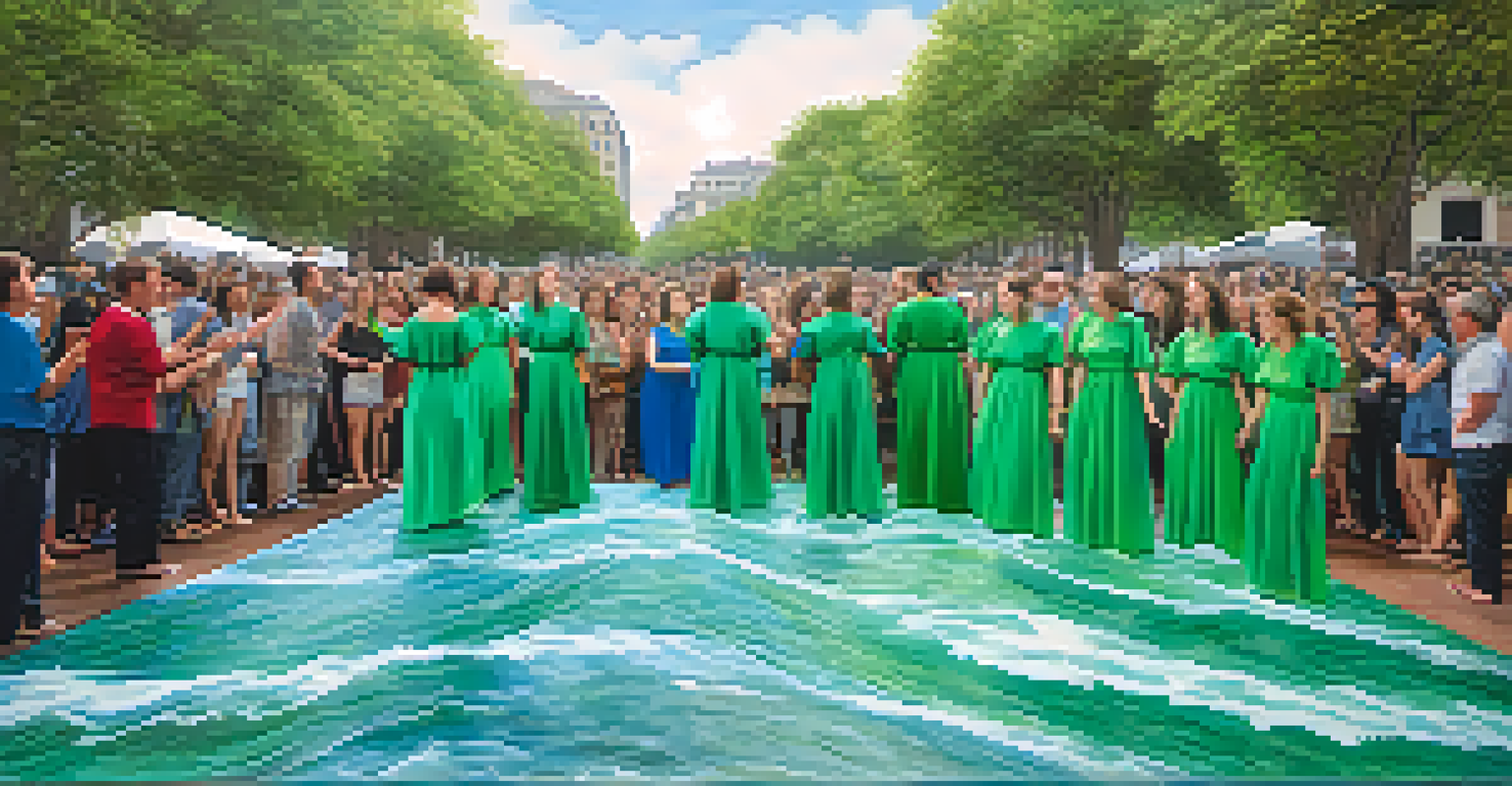The Role of Art in Raising Awareness for Climate Change

Art as a Powerful Medium for Climate Messaging
Art has an incredible ability to convey complex emotions and ideas, making it a powerful tool for climate messaging. Through various forms, such as paintings, sculptures, and installations, artists can express urgent messages about climate change in a way that resonates deeply with audiences. This emotional connection can often provoke a stronger response than traditional scientific data alone.
Art enables us to find ourselves and lose ourselves at the same time.
For example, a striking visual representation of rising sea levels can make the abstract concept of climate change more tangible and relatable. When people see these artistic interpretations, they may feel a sense of urgency and a personal connection to the issue. This emotional engagement is crucial in motivating individuals to reconsider their own behaviors and attitudes toward the environment.
Moreover, art can transcend language barriers, reaching a broader audience. A single piece of art can spark conversations and inspire action, even among those who may not be familiar with the specifics of climate science. This universal appeal makes art an invaluable ally in the fight against climate change.
Highlighting Environmental Issues through Visual Art
Visual art plays a significant role in highlighting environmental issues by capturing the beauty of nature and the consequences of its degradation. Artists often use their work to showcase the stark contrast between thriving ecosystems and the impact of human activity, creating a narrative that compels viewers to reflect on their role in this story. By depicting scenes of deforestation, pollution, or melting ice caps, they bring these issues to the forefront of public consciousness.

Take, for instance, the work of renowned photographer Sebastião Salgado, whose breathtaking images of landscapes and wildlife serve as a reminder of what is at stake. His powerful visuals not only evoke admiration but also a sense of responsibility towards preserving our planet. Such artworks encourage individuals to appreciate nature and recognize the urgent need for conservation efforts.
Art Connects Emotion to Climate Action
Art effectively conveys complex environmental issues, prompting emotional connections that inspire individuals to take action.
In essence, visual art acts as a mirror, reflecting the state of our environment while prompting critical discussions about sustainability. When people engage with these images, they are often moved to advocate for change, whether through personal lifestyle modifications or support for broader environmental initiatives.
The Role of Performance Art in Climate Advocacy
Performance art adds a dynamic element to climate advocacy, often incorporating movement and interaction to engage audiences in real-time. This form of art can create immersive experiences that allow participants to feel the urgency of climate issues on a personal level. For example, a performance might involve choreographed movements that symbolize the rising seas or the struggle of endangered species, making the message not just seen but felt.
The greatest threat to our planet is the belief that someone else will save it.
One notable example is the work of the artist group Climate Guardians, who have staged various performances to highlight climate injustices. Their interactive pieces invite the public to participate, fostering a sense of community and shared responsibility. This engagement can lead to a more profound understanding of climate change and its implications.
Ultimately, performance art transforms the passive act of viewing into an active experience, encouraging audiences to reflect on their relationship with the environment. By engaging emotions and senses, performance art can leave a lasting impact, driving home the importance of climate action in a way that traditional forms may not achieve.
The Influence of Digital Art and Social Media
In our increasingly digital world, art has found a new platform through social media, allowing it to reach wider audiences than ever before. Digital art, from infographics to animated videos, can distill complex climate data into visually engaging formats. These pieces can go viral, spreading awareness quickly and sparking conversations around climate change.
For instance, artists like Olafur Eliasson use digital platforms to showcase their work and share critical messages about climate action. By creating content that is easily shareable, they can inspire a global audience to engage with environmental issues. This democratization of art allows individuals from all walks of life to participate in the dialogue around climate change.
Visual Art Highlights Environmental Issues
Through stunning imagery, visual art captures the beauty of nature and the stark realities of environmental degradation.
Moreover, social media provides an avenue for grassroots movements, where artists and activists can collaborate, share their work, and amplify their voices. This collective effort can lead to significant awareness and mobilization, illustrating the power of digital art in advocating for a sustainable future.
Art Exhibitions Focused on Climate Change
Art exhibitions dedicated to climate change serve as a gathering place for artists, activists, and the public to engage with the pressing issues facing our planet. These events often showcase a variety of works that explore themes of environmental degradation, sustainability, and hope. By bringing together diverse perspectives, exhibitions can foster meaningful dialogue and inspire action.
One notable example is the 'Art for the Earth' exhibition, which features artworks that address climate change directly. Visitors are not only treated to stunning visuals but are also encouraged to reflect on their role in the environmental crisis. The combination of beauty and urgency can be a powerful catalyst for change.
Additionally, these exhibitions often collaborate with environmental organizations, further bridging the gap between art and activism. By creating a space for education and discussion, art exhibitions can motivate attendees to take concrete steps toward combating climate change.
Art as a Tool for Education and Awareness
Art can serve as a vital educational tool, particularly in raising awareness about climate change among younger generations. Integrating art into educational programs can make learning about the environment more engaging and impactful. For instance, students might create their own artworks that express their understanding of climate issues, deepening their connection to the subject matter.
Projects like Earth Day Network's 'Art for the Earth' encourage students to use their creativity to address environmental challenges. By fostering artistic expression, these initiatives help cultivate a sense of responsibility and empowerment in young people. When students realize that their voices can be amplified through art, they are more likely to become lifelong advocates for the planet.
Community Engagement Through Art
Collaborative art projects unite communities and encourage dialogue, fostering a collective commitment to addressing climate change.
Ultimately, art education can inspire a new generation to think critically about climate change and its implications. By nurturing creativity alongside environmental awareness, we can empower young artists to become the changemakers of tomorrow.
Collaborative Art Projects and Community Engagement
Collaborative art projects can unite communities around a common cause, fostering a sense of shared purpose in addressing climate change. These projects often bring together artists, activists, and local residents to create collective works that reflect their concerns and aspirations for the environment. This participatory approach encourages dialogue and strengthens community bonds.
For example, community murals can serve as visual reminders of local environmental issues, transforming public spaces into platforms for awareness. When residents contribute to the creation of these murals, they invest themselves in the message, amplifying its impact. This sense of ownership can inspire individuals to take further action, both within their community and beyond.

Moreover, collaborative projects can highlight the unique environmental challenges faced by specific areas, allowing for tailored solutions and engagement. By harnessing the power of collective creativity, these initiatives can drive meaningful change and foster a culture of environmental stewardship.